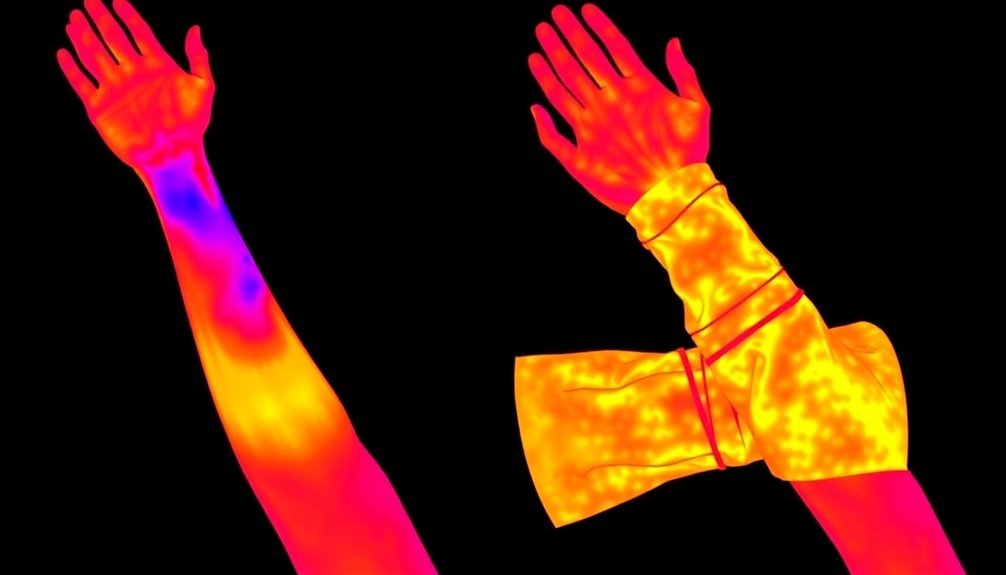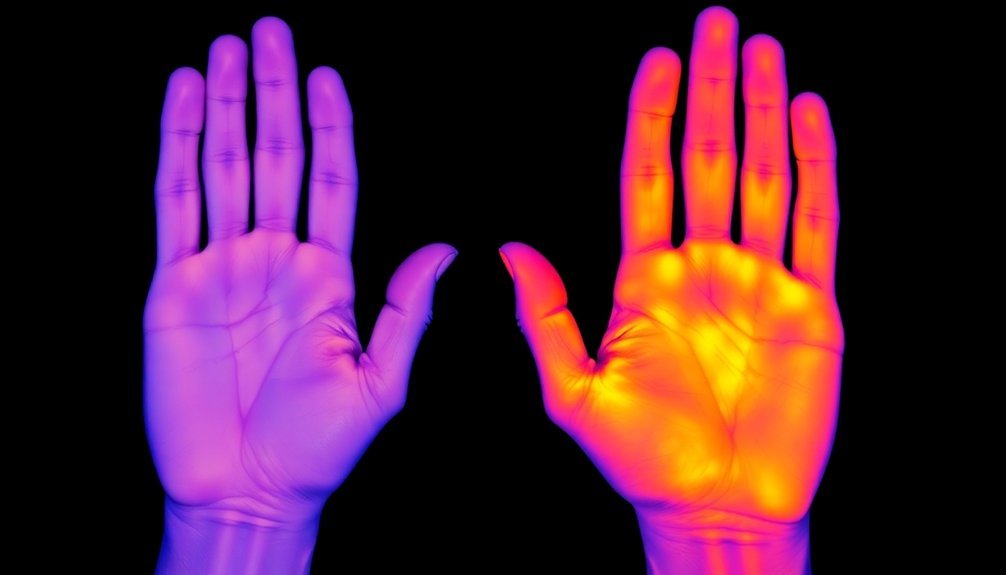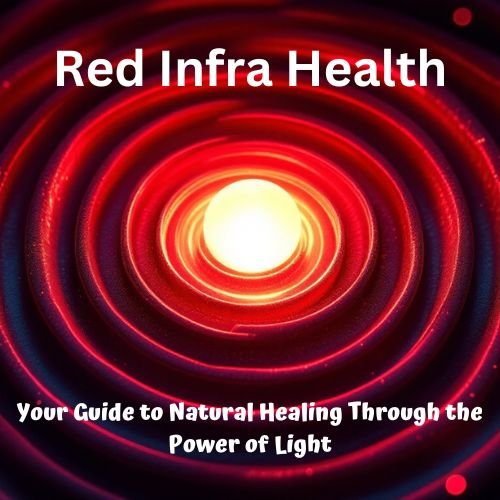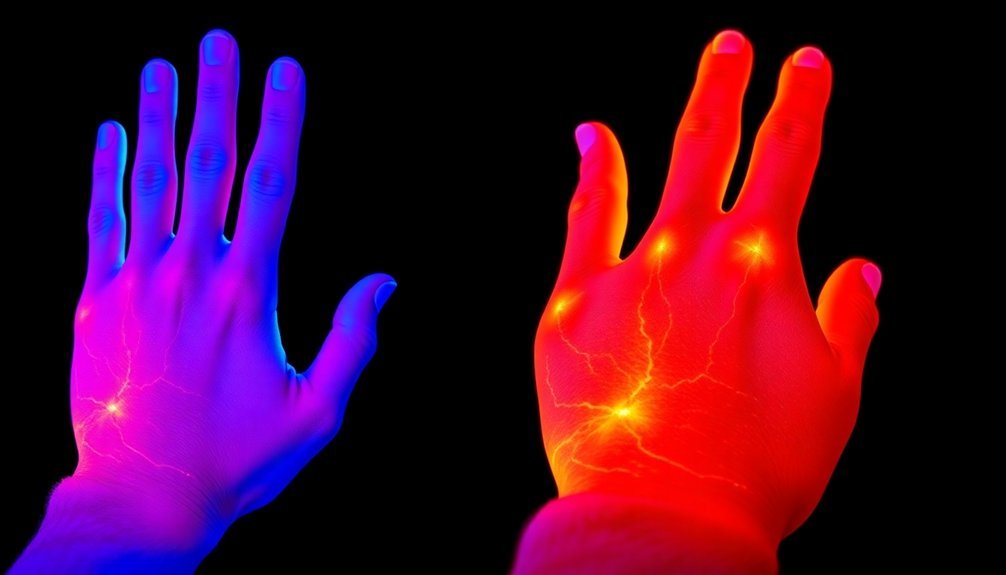Heat therapy makes your blood flow better by causing your blood vessels to dilate and expand, creating wider pathways for blood to travel through your body. This process, called vasodilation, helps deliver more oxygen and nutrients to your tissues while lowering your blood pressure. When you apply heat, your heart's output increases, and your metabolic rate speeds up, further enhancing circulation throughout your system. Your body also produces special heat shock proteins that improve cellular function and protect your tissues. Understanding how heat affects your circulation reveals even more surprising benefits for your overall health.
Understanding Blood Flow Changes

Monitoring blood flow changes in response to temperature reveals fascinating insights about the body's regulatory systems. When you're exposed to heat, your blood vessels naturally dilate, increasing blood flow to your extremities and skin surface. This process, known as vasodilation, is your body's way of regulating temperature and promoting healing.
You'll notice that heat therapy directly impacts your cardiovascular system by reducing mean arterial, systolic, and diastolic blood pressure. When you apply heat to a specific area, it doesn't just affect that location – it triggers a chain reaction throughout your body's vascular network. Heat therapy has proven particularly effective for peripheral artery disease, helping to improve circulation in narrowed arteries.
Your metabolic rate increases, leading to greater oxygen uptake and accelerated tissue healing in the treated areas.
The body's response to temperature isn't just automatic; it's precisely controlled. When you're cold, your blood vessels constrict to preserve core temperature, but when you're hot, they widen to help release excess heat.
Understanding these mechanisms is vital because they explain why heat therapy works so effectively for various conditions, from muscle pain to circulation problems. It's your body's natural temperature regulation system at work, and you can harness it therapeutically through controlled heat application.
Heat Effects On Blood Vessels
Understanding how heat affects your blood vessels reveals a remarkable physiological response. When you're exposed to heat, your blood vessels naturally dilate, creating wider pathways for blood to flow through. This process, called vasodilation, helps your body regulate temperature by bringing more blood to your skin's surface, where heat can dissipate. During this process, your body can increase blood flow by up to four times normal levels.
| Heat Effect | Physiological Response |
|---|---|
| Vasodilation | Blood vessels widen to increase flow |
| Temperature Control | More blood reaches skin surface |
| Blood Flow | Oxygen and nutrient delivery improves |
| Vascular Health | Long-term function enhancement |
| Blood Pressure | Natural reduction through improved flow |
While heat therapy can substantially improve your circulation and vascular health, you'll need to be cautious about potential risks. If you have heart conditions or varicose veins, you might need to limit your heat exposure. The key is maintaining proper hydration and avoiding excessive heat, which could lead to heat stress. Regular, controlled heat therapy can enhance your vascular function and promote better blood flow, but you'll get the best results by following appropriate guidelines and listening to your body's responses.
Healing Through Better Circulation

Anyone seeking to heal from wounds or injuries can benefit from improved circulation, as better blood flow accelerates the recovery process. You'll find that combining physical activity with proper nutrition creates a favorable environment for healing. Movement prevents blood pooling in the legs and feet, which is crucial for tissue repair.
Regular gentle exercises like walking or swimming stimulate blood flow without overstressing injured areas, while a balanced diet rich in berries, leafy greens, and fatty fish supports your body's natural healing mechanisms.
To maximize your healing potential, you'll want to incorporate therapeutic interventions alongside lifestyle changes. Elevating wounded areas and using compression garments can substantially improve blood flow to affected regions. If you're dealing with limited mobility, frequent repositioning helps prevent pressure sores while maintaining healthy circulation.
- Stay hydrated to keep your blood flowing smoothly through vessels and guarantee efficient nutrient transport to healing tissues
- Engage in gentle resistance training to build muscle and enhance vascular connections, leading to improved circulation
- Combine physical therapy techniques like massage, deep moist heat, and ultrasound for targeted circulation improvement
Remember to avoid harmful substances like excessive caffeine, salt, and alcohol, as these can interfere with your body's fluid balance and circulation.
Vascular Benefits Of Heat
Heat therapy stands as a powerful tool for enhancing vascular health, building upon the circulation benefits we discussed earlier.
When you expose your body to therapeutic heat, you'll experience multiple improvements in your vascular system, including reduced blood pressure and enhanced blood vessel function.
Your blood vessels become more flexible and compliant through heat therapy, as it activates important heat shock proteins that improve cellular function. These proteins help protect your tissues and enhance your body's ability to handle stress.
You'll also benefit from increased cardiac output and better blood flow distribution throughout your body, particularly to peripheral areas.
If you're unable to exercise due to injury or illness, you'll find heat therapy particularly valuable. It can help preserve your arterial health similarly to exercise, reducing your risk of cardiovascular disease. Regular heat exposure through sauna bathing reduces mortality from cardiovascular-related causes.
The therapy works by creating beneficial patterns of blood flow that promote vascular remodeling and reduce inflammation.
Whether you're healthy or managing a medical condition, you can combine heat therapy with exercise for enhanced benefits. Your blood vessels respond to the heat by dilating more effectively, improving overall circulation and vascular function.
Optimal Treatment Methods

Effective treatment planning requires careful consideration of both heat delivery methods and best application times.
You'll get the best results by using moist heat, which penetrates tissues more effectively than dry heat due to water's superior heat conductivity. For maximum blood flow enhancement, maintain temperatures between 95-109 degrees F and limit your sessions to 20-25 minutes.
When treating deeper tissues, you'll want to use electrotherapy methods like ultrasound or infrared radiation. These techniques can reach blood vessels and muscles that surface-level heating can't access. Remember to monitor the temperature regularly and never exceed 30 minutes of continuous application to prevent skin irritation or burns.
- Use moist heat wraps or hot packs for superficial tissue treatment, maintaining consistent temperature throughout the session
- Choose ultrasound or infrared therapy when targeting deep tissue circulation issues
- Combine heat therapy with gentle movement or stretching to maximize blood flow benefits
For enhanced effectiveness, you can apply heat before physical activity to improve your range of motion and reduce muscle stiffness. This pre-workout application helps optimize blood flow and prepare your tissues for exercise.
Long Term Cardiovascular Improvements
Regular exposure to therapeutic heat delivers significant cardiovascular benefits that extend well beyond immediate comfort. When you consistently engage in heat therapy, you'll experience measurable improvements in your cardiovascular system, including reduced blood pressure and enhanced vascular function.
Research shows that your mean arterial pressure can drop by nearly 6 mmHg, while both systolic and diastolic pressures decrease by approximately 4 mmHg.
These improvements aren't just temporary – they translate into long-term health benefits. If you maintain regular heat therapy sessions, you'll likely experience better endothelial function and increased vascular compliance. The benefits are particularly pronounced if you're over 60 or dealing with chronic heart conditions.
What's more, studies indicate that frequent heat therapy users have lower rates of cardiovascular disease and stroke-related mortality.
The science behind these improvements is clear: heat therapy triggers your body's natural cardiovascular responses by increasing core temperature and modulating your autonomic nervous system. It also reduces inflammation and positively affects your circulating vascular risk factors.
Whether you're young and sedentary or managing a heart condition, you'll find heat therapy's cardiovascular benefits are both substantial and sustainable.
Frequently Asked Questions
Can Heat Therapy Help With Blood Clots?
No, you shouldn't use heat therapy for blood clots. It's dangerous because it can dislodge clots and send them to your lungs or brain. Heat also increases blood flow, which worsens swelling and pain.
Does Combining Heat Therapy With Exercise Provide Additional Blood Flow Benefits?
Yes, when you combine heat therapy with exercise, you'll experience enhanced blood flow benefits. The heat expands your blood vessels while exercise increases circulation, creating a synergistic effect that boosts overall vascular performance.
How Does Altitude Affect Heat Therapy's Effectiveness on Blood Circulation?
You'll notice changes in heat therapy's effectiveness at higher altitudes since reduced oxygen levels already affect your circulation. While heat still promotes blood flow, altitude's impact on your vessels may partially counteract these benefits.
Can Heat Therapy Improve Circulation in People With Diabetes?
Yes, you'll find heat therapy can markedly improve your circulation if you have diabetes. It dilates your blood vessels, enhances insulin sensitivity, and increases blood flow, which helps combat the circulatory issues common in diabetic patients.
Will Heat Therapy Benefit Those Taking Blood Pressure Medications?
If you're on blood pressure medications, heat therapy can benefit you by enhancing your treatment's effectiveness. However, you'll need to consult your doctor first, as combining therapies requires careful monitoring for safety.
In Summary
You've learned how heat therapy can substantially improve your blood flow through vessel dilation and increased circulation. Whether you're using a heating pad, sauna, or hot bath, you'll experience enhanced vascular function and better healing. Remember to apply heat therapy correctly and consistently to maximize its benefits. By incorporating heat treatments into your routine, you'll support your body's natural healing processes and cardiovascular health.





Leave a Reply